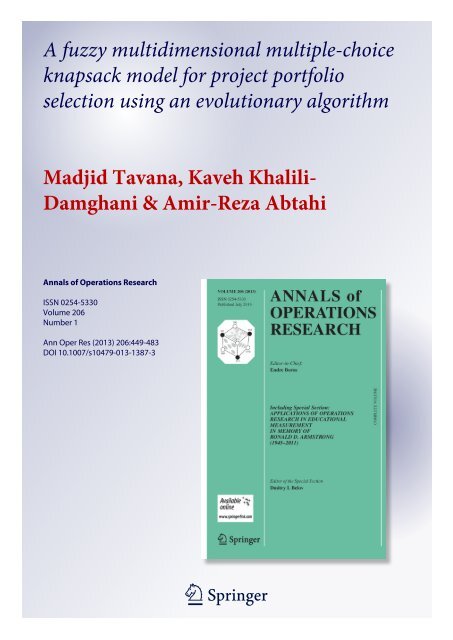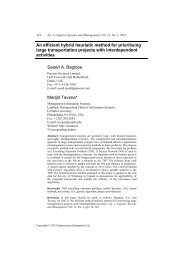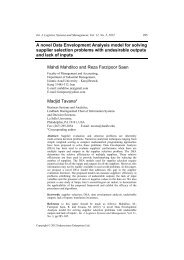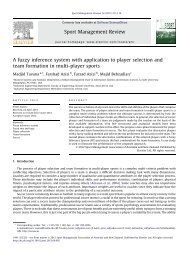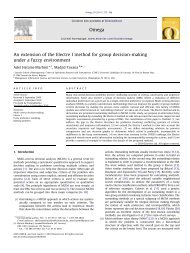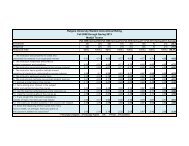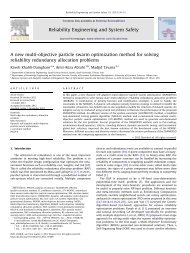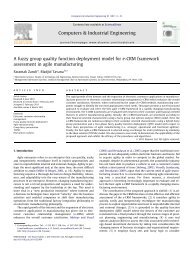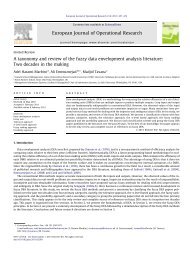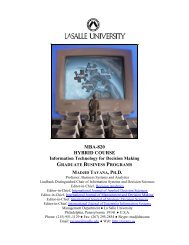A Fuzzy Multidimensional Multiple-Choice Knapsack - Dr. Madjid ...
A Fuzzy Multidimensional Multiple-Choice Knapsack - Dr. Madjid ...
A Fuzzy Multidimensional Multiple-Choice Knapsack - Dr. Madjid ...
You also want an ePaper? Increase the reach of your titles
YUMPU automatically turns print PDFs into web optimized ePapers that Google loves.
A fuzzy multidimensional multiple-choiceknapsack model for project portfolioselection using an evolutionary algorithm<strong>Madjid</strong> Tavana, Kaveh Khalili-Damghani & Amir-Reza AbtahiAnnals of Operations ResearchISSN 0254-5330Volume 206Number 1Ann Oper Res (2013) 206:449-483DOI 10.1007/s10479-013-1387-31 23
450 Ann Oper Res (2013) 206:449–4831 IntroductionThe knapsack problem is best described by a problem where a hitchhiker is searching for acombination of different items that maximizes the total value of all chosen items in his/herknapsack. The multiple objective knapsack problem is a well-known combinatorial optimizationproblem with a wide range of business applications in capital budgeting (Bas 2011)and production planning (Camargo et al. 2012; Morenoetal.2010) among others. A goodreview of the single knapsack problem and its associated exact and heuristic algorithms isavailable in Martello and Toth (1990).The <strong>Multidimensional</strong> <strong>Multiple</strong>-choice <strong>Knapsack</strong> Problem (MMKP) (as a generalizationof the single knapsack problem) is one of the most complex forms of the knapsack problemfamily. Given a set of knapsacks with limited resources and some disjoint groups of items,the MMKP aims to fill the knapsacks by picking exactly one item from each group, such thatthe total profit value of the collected items is maximized and none of the resource constraintsare violated (Crévits et al. 2012; Han et al. 2010; Ghasemi and Razzazi 2011). The MMKPsare NP-hard optimization problems where the computing time grows exponentially withproblem size (Kellerer et al. 2004). Several heuristic and meta-heuristic approaches havebeen proposed to solve MOMDKP (Florios et al. 2010; Shah and Reed 2011; Aghezzaf andNaimi 2009; Alves and Almeida 2007).Data Envelopment Analysis (DEA) has been used to compare project efficiencies inmulti-project environments (Cook and Green 2000; Farris et al. 2006; Vitner et al. 2006;El-Mashaleh et al. 2010; Ghapanchi et al. 2012). However, the inability to clearly discriminateamong the outputs often hinders its popularity and wide-spread use in project selectionproblems. Alternatively, the knapsack formulation could be used to formulate the problem ofmaximizing profit under constrained resources (Lin and Yao 2001; Lin2008). A drawbackof the knapsack problem is its inability to fully take into consideration the ranking of theprojects according to their objective values because of the additivity in the objective functionand the constraint equations in the integer programming model (Cook and Green 2000;Mavrotas et al. 2008). The real-world project selection problems aim at selecting a portfolioof projects that achieves organizational objectives without exceeding limited capitalresources. Generally speaking, the environment is assumed to be uncertain and the projectis assumed to possess imprecise or ambiguous data. The hybrid frameworks composed ofDEA and the knapsack formulation are most suitable for solving these optimization problems(Chang and Lee 2012).The project portfolio selection and capital budgeting problems are often formulated asknapsack problems. Khalili-Damghani et al. (2011) proposed a modular decision supportsystem for optimum investment selection in the presence of uncertainty. They used a combinationof fuzzy mathematical programming and a fuzzy rule based system to solve theinvestment problem based on the knapsack problem. Khalili-Damghani et al. (2012) proposedan integrated multi-objective framework for solving multi-period project selectionproblems. The proposed multi-objective model was a variant of the multi-objective multidimensionalmulti-period knapsack problem. Khalili-Damghani and Sadi-Nezhad (2013)proposed a decision support system for solving fuzzy multi-objective multi-period sustainableproject selection problems. The proposed multi-objective model which was a variantof the multi-objective multi-dimensional multi-period knapsack problem was solved by anew fuzzy goal programming method. More recently, Khalili-Damghani et al. (2013c)comparedthe performance of a partial bound enumeration algorithm and an efficient variant ofthe epsilon-constraint method which was used to solve several benchmark instances of the
Ann Oper Res (2013) 206:449–483 451fuzzy multi-dimensional multiple-choice knapsack problems. They compared the performanceof the two methods statistically with respect to a set of simulated benchmark casesusing different diversity and accuracy metrics.In this paper, the knapsack formulation, an Efficient Epsilon-Constraint (EEC) method,and a customized multi-objective evolutionary algorithm are integrated into a structuredbut yet flexible model for solving the project selection problems in fuzzy environments.The proposed integrated model is not subject to the abovementioned drawbacks of DEAand the knapsack formulation, and also selects a portfolio of projects with fuzzy input andoutput data with respect to organizational objectives and resource constraints. Moreover, thecurrent MMKPs in the literature are formulated to fill the knapsacks by picking exactly oneitem from each group. However, this assumption may be difficult to quantify in real worldproblems where the membership of an item to a group is not precise. In the proposed modelwe represent the membership function with fuzzy numbers rather than precise numbers.The remainder of the paper is organized as follows: A review of the relevant literatureon knapsack problems and DEA models is presented in Sect. 2. The details of the proposedframework including the problem definition, the solution procedures, and the pruningmethod are presented in Sect. 3. A real-world case study is presented in Sect. 4 to demonstratethe applicability of the proposed framework and exhibit the efficacy of the proceduresand algorithms. The results of the experiment are presented in Sect. 5. Finally, we end thepaper with conclusions and future research directions in Sect. 6.2 Literature reviewA multi-objective decision making model is composed of a vector of decision variables,objective functions, and constraints. The Decision Makers (DMs) are expected to considerthe available resources and constraints while optimizing multiple objective functions. Letus consider the following definitions for multi-objective decision making problems (Hwangand Masud 1979):Definition 1.1 x ∗ is said to be a complete optimal solution, if and only if there exists x ∗ ∈X such that f i (x ∗ ) ≤ f i (x), i = 1,...,k,forallx ∈ X. Also, the ideal solution, superiorsolution, orutopia point are equivalent terms indicating a complete optimal solution. Ingeneral, such a complete optimal solution that simultaneously minimizes all of the objectivefunctions does not always exist when the objective functions conflict with each other.Definition 1.2 x ∗ is said to be a Pareto optimal solution, if and only if there does not existanother x ∈ X such that f i (x) ≤ f i (x ∗ ) for all i and f j (x) < f j (x ∗ ) for at least one j. ThePareto optimal solution is also named differently by different disciplines: non-dominatedsolution, non-inferior solution, efficient solution, andnon-dominate solution.Definition 1.3 x ∗ is said to be a weak Pareto optimal solution, if and only if there does notexist another x ∈ X such that f i (x) ≤ f i (x ∗ ), i = 1,...,k.Let X CO , X P ,andX WP denote complete optimal, Pareto optimal, and weak Pareto optimalsolution sets, respectively. We can easily obtain X CO ⊆ X P ⊆ X WP from the abovedefinitions.Multi-objective decision making problems often do not have a unique solution and thereforethe DMs are required to choose a solution from the set of efficient solutions (Hwang
452 Ann Oper Res (2013) 206:449–483and Masud 1979). The process may also require the articulation of the DMs’ preferences.Depending upon the kind of preference information needed, Hwang and Masud (1979)haveclassified the multi-objective decision making techniques into the following four classes:(a) no articulation of preference information; (b) a priori articulation of preference information;(c) progressive articulation of preference information or interactive methods; and(d) a posterior articulation of preference information or non-dominated solution generationmethods. The EEC method is a non-dominated solutions generation method proposed byChankong and Haimes (1983).2.1 Epsilon-constraint methodA special kind of multi-objective decision making problems, including linear programming,produces the entire efficient set. These methods can provide a representative subset of thePareto set which in most cases is adequate. In the Epsilon-constrained method, the DMchooses one objective out of n to be optimized. For a multi-objective decision making problemwith minimization objective functions, the remaining objectives are constraints as theyare assumed to be less than or equal to some given target values. In mathematical terms,by selecting f j (x), j ∈{1,...,k}, as the objective function to be optimized, we have thefollowing problem P(ε j ), j ∈{1,...,k}:min { f j (x), j ∈{1,...,k}; f i (x) ≤ ε i , ∀i ∈{1,...,k}, i≠ j; x ∈ S }where, S is the feasible solution space.One advantage of the Epsilon-constraint method is that it is able to generate efficientpoints in a non-convex Pareto curve. Therefore, the DM can vary the upper bounds ε i to obtainweak Pareto optima. Clearly, this is also a drawback of this method since the DM has tochoose appropriate upper bounds for the ε i values. Moreover, the method is not particularlyefficient if the number of objective functions increase. Several studies have focused on improvingthe Epsilon-constraint method (Mavrotas 2009). The traditional Epsilon-constraintmethods are designed to find the efficient solutions to the problems by means of parametricalvariation in the right-hand-side of the constraints. More formally, the implementationof the Epsilon-constraint methods requires attention to: (a) the calculation of the range ofthe objective functions over the efficient set; (b) the guarantee of efficiency of the obtainedsolution; and (c) the increased solution time for problems with several (more than two) objectivefunctions. Mavrotas (2009) proposed a novel Epsilon-constraint method to addressthese issues.2.2 Non-dominated sorting genetic algorithm (NSGA-II)The Non-dominated Sorting Genetic Algorithm II (NSGA-II) is a well-known multiobjectiveevolutionary algorithm first introduced by Deb et al. (2002). The NSGA-II hasbeen successfully applied in a wide range of engineering, management, and combinatorialoptimization problems because it contains appropriate properties, such as elitism, fastnon-dominated sorting and diversity maintenance along the Pareto-optimal front. A briefdescription of the mechanism of NSGA-II is provided here.Each chromosome in a population is sorted based on non-domination into each front. Thefirst front contains only non-dominant chromosomes among all chromosomes; the chromosomesin the second front are dominated by the chromosomes in the first front as this patternis repeated. Each chromosome in each front is assigned a ranking in accordance to the frontwhere it belongs to. Chromosomes in the first front are given a fitness value of 1, the chromosomesin the second front are assigned a fitness value of 2, and so forth.
Ann Oper Res (2013) 206:449–483 453A measure, called crowding distance, is calculated for each individual in the NSGA-IIpopulation. The crowding distance is a measure of how close an individual is to its neighbors.A large average crowding distance will result in an increased diversity in the population.Parents are selected from the population by using a binary tournament selectionprocedure based on their rank and crowding distance. The fitness of an individual, whichbelongs to a given rank, is less than others in the same rank with a greater crowding distance.The selected population generates offspring through crossover and mutation operators. Allindividuals, including the current population and the offsprings, are sorted again based onnon-domination. Only the best N individuals are selected, where N is the population size.The selection is based on the rank and crowding distance on the last front. The details of theNSGA-II can be found in Deb et al. (2002).NSGA-II is one of the most successful evolutionary computation algorithms. There areseveral successful applications of the NSGA-II algorithm in recent years. Khalili-Damghaniet al. (2013b) proposed a hybrid fuzzy rule-based multi-criteria framework for sustainableproject portfolio selection. They used the NSGA-II algorithm to generate non-dominatedsets of fuzzy rules for an interpretable-accurate fuzzy rule-based system with three conflictingobjectives. Khalili-Damghani et al. (2013a) proposed a new multi-objective particleswarm optimization method for solving the reliability redundancy allocation problems. Theyused the NSGA-II algorithm to assess the performance of a new multi-objective particleswarm optimization model based on benchmark cases.2.3 Brief review of the DEA literatureThe DEA is a mathematical programming approach that was initially developed as an efficiencyanalysis tool by Charnes et al. (1978). DEA uses the production metaphor of anentity, referred to as a Decision Making Unit (DMU), using inputs to produce outputs. DEAis able to compare DMUs using multiple criteria with different units of measurement whileutilizing all inputs and outputs simultaneously. DEA is capable of: (1) identifying the best alternative;(2) ranking the alternatives; or (3) establishing a shortlist of the better alternativesfor detailed review (Cook and Green 2000).DEA has been used in solving project selection problems. Sowlati et al. (2005)presenteda new model within the DEA for prioritizing information system projects. They used theinputs and outputs of the model as the criteria that judge the importance of the projects. A setof sample projects was created for which the criteria and priority scores were assigned by theDMs who compared each project to the set of defined projects. The new model was tested ona real case of prioritizing information system projects at a large financial institution. Theirmodel provided a fair and equitable ranking and a new project could be prioritized at anytime without affecting the priority of already assessed projects.Vitner et al. (2006) investigated the possibility of using the DEA method for evaluatingthe performances of projects in a multi-project environment where each project was a onetimenon-recurring event. Projects were evaluated by the earned value management systemand multidimensional control system methods. They also proposed a method to reduce thenumber of inputs and outputs because it was usually necessary for the number of inputs andoutputs not to exceed the number of projects.Eilat et al. (2006) proposed a methodology for the construction and analysis of efficient,effective and balanced portfolios of projects with interactions. Their methodology was basedon an extended DEA model that quantified some of the qualitative concepts embedded in thebalanced scorecard approach. Their methodology included: a resource allocation scheme, anevaluation of individual projects, a screening of projects based on their relative values, and
Ann Oper Res (2013) 206:449–483 455norm fuzzy relations and developed surrogate relaxation models of the defuzzified problems.He then proposed a methodology for multi-attribute project portfolio selection and consideredthe optimal solutions from the original defuzzified problems as well as the near-optimalsolutions from the surrogate relaxation models. He used a simple and effective fuzzy simpleadditive weighting method to manage the aggregation of evaluation results. Chang andLee (2012) discussed the specific problem of selecting a portfolio of projects that achievedorganizational objectives without exceeding limited capital resources in a fuzzy environment.They proposed an integrated DEA-knapsack formulation with fuzzy data and appliedtheir model to a real-world problem in the engineering-procurement-construction industry.They applied three constraint handling techniques to transform their constrained optimizationproblem into an unconstrained problem, and for the first time used an artificial beecolony algorithm for the solutions.3 The proposed frameworkThe hybrid framework proposed in this study is depicted in Fig. 1. The overall framework iscomprised of three distinct but inter-related phases including: problem definition, solutionprocedures and pruning procedure.As shown in Fig. 1, the first phase consists of modeling the new fuzzy knapsack problemand defining the new fuzzy project selection problem. The second phase consists of twosolution procedures proposed to solve the multi-period project selection problem. The firstprocedure is an EEC method and the second procedure is a multi-objective evolutionaryalgorithm. A DEA model is used in the last phase of the proposed framework to prune thesolutions found in the previous phase.3.1 Phase I: Problem definitionIn this phase, a new multi-objective knapsack problem and a multi-period project selectionproblem are defined as follows:3.1.1 New fuzzy multidimensional multiple-choice knapsack modelWe use the notations presented in Table 1 to model the new fuzzy knapsack problem.Let us also denote G j , j = 1,...,k; to represent the set of objects with membership ingroup j. If each object i belongs to just one group, where μ ij is the membership value ofobject i in group j, wehave:{ 1 if i ∈ Gj ,μ ij =i = 1,...,n; j = 1,...,k (1)0 if i/∈ G j ,Then, the MMKP can be re-formulated as follows:n∑max pi l x i, l = 1,...,oi=1n∑wi d x i ≤ W d ,i=1n∑μ ij .x i = 1,i=1x i ∈{0, 1},d = 1,...,mj = 1,...,ki = 1,...,n(2)
Ann Oper Res (2013) 206:449–483 457Table 1 The parameters used in the proposed fuzzy MMKPSetsG j Set of items in group jG α j Set of objects with sufficient relations in group jIndicesi Index of items (objects) i = 1, 2,...,nj Index of groups j = 1, 2,...,kl Index of objective functions l = 1, 2,...,od Index of dimensions d = 1, 2,...,mParametersn Number of items (objects)k Number of groupso Number of objective functionsm Number of dimensionsPi l The profit of item i in objective l i = 1, 2,...,n; l = 1, 2,...,owi d Weight of object i in dimension d i = 1, 2,...,n; d = 1, 2,...,mW d Total capacity of dimension d of knapsack d = 1, 2,...,mμ ij Membership value of object i in group j i = 1, 2,...,n; j = 1, 2,...,k∼= The sign of soft (fuzzy) equalDecision variablesX i Binary decision variable: Equals to 1 if item i is selected; and 0otherwisei = 1, 2,...,nthe membership degree of each selected object in the group is low. In order to avoid theseundesirable circumstances, the selected objects in a group should have sufficient relations.An object has sufficient relations in a group if its membership degree in that group is equalto or greater than a pre-defined parameter. In other words, the final solution must include atleast one object with sufficient relations. Therefore, the new fuzzy version of Model (2) canbe formulated as follows:n∑max pi l x i, l = 1,...,oi=1n∑wi d x i ≤ W d ,i=1n∑μ ij .x i∼ = 1,∑i=1x i ≥ 1,i∈G α jx i ∈{0, 1},d = 1,...,mj = 1,...,kj = 1,...,ki = 1,...,nwhere, G α jis the set of objects with sufficient relation in group j and is represented as:G α j = { i | μ ij ≥ α } , j = 1,...,k (4)The sign ∼ = represents the fuzzy membership degree of the items in each group (the associatedconstraint is written for each group). Since objects in the classical multidimensionalmultiple-choice 0–1 knapsack problems belong to one group, the number of selected objectsin the final solution is equal to the number of groups (i.e. k). However, in Model (3),(3)
458 Ann Oper Res (2013) 206:449–483Table 2 The notations used in the proposed fuzzy MMKPIndicesj Index of groups of projects j = 1,...,ki Index of projects i = 1,...,no Types of resources o = 1,...,zt The planning horizon t = 1,...,TParametersk Number of groups of projectsn Number of projectsz Number of type of resourcesT Number of planning horizonsR ot Maximum available resource of type o in time period t o= 1,...,z; t = 1,...,Tr oit Required resource of type o in project i in time period t o= 1,...,z; i = 1,...,n; t = 1,...,TB it Maximum available budget for project i in time period t i = 1,...,n; t = 1,...,TC ot Unit cost of resource of type o in time period t o= 1,...,z; t = 1,...,Tp it Total net profit of project i in time period t i = 1,...,n; t = 1,...,Td it Duration of project i in time period t i = 1,...,n; t = 1,...,Tμ ij t Membership degree of project i in group j in time period t i = 1,...,n; j = 1,...,k; t = 1,...,TDecision variables{x ij t0 otherwise1 if project i is selected in group j for investment in period tthe objects have fuzzy membership degrees and therefore the number of objects in the finalsolution may be not equal to k.3.1.2 <strong>Fuzzy</strong> multi-objective multi-period project selection problemA multi-period project selection problem is defined in order to demonstrate the real-worldapplications of the proposed fuzzy Model (3). Suppose an investor is facing several manufacturingand service investment opportunities in a finite planning horizon. The final outputof these investment opportunities is a mixture of goods and service. In other words, an investmentopportunity is not purely a production or service endeavor. In that case, the investoris interested in selecting a portfolio of investment opportunities with multiple objective functionssuch as profit, cost and time subject to a series of resource and planning horizon constraints.This problem can be modeled as a multi-period version of Model (3) consideringadditional constraints where the investment opportunities are goods and services. The factthat the outcome of an investment opportunity is a mixture of goods and services representsthe fuzzy membership of each investment opportunity. The notations used to model the newmulti-objective multi-period project selection problem are presented in Table 2.Considering Model (3), we propose a mathematical programming model for fuzzyMMKP. The objective in the proposed model is to select a portfolio of projects with maximumtotal profit, minimum total cost and minimum total time. The constraints are availableresources, the aforementioned rough project classification (i.e., goods and services) and the
460 Ann Oper Res (2013) 206:449–483fourth set of constraints is written for all projects and all time periods of the planning horizons.The fifth set of constraints guarantees that each project is selected in one group in eachtime period of the planning horizon. The sixth set of constraints guarantees that each projectin each group is selected in one time period during the planning horizon. The seventh set ofconstraints guarantees that each project will be selected and implemented within a restrictedwindow of time in the planning horizon. The eighth set of constraints defines the binary stateof the decision variables in the model.Model (5) is a real-world and extended multi-period version of Model (3). In real-worldmulti-objective problems such as Model (5), generating a set of non-dominated solutions onthe Pareto front is preferred.3.2 Phase II: Solution proceduresIn Phase II, an EEC method and a customized multi-objective evolutionary algorithm procedureare proposed to solve Model (5).3.2.1 The efficient Epsilon-constraint methodWe apply the EEC method proposed by Mavrotas (2009) to Model (5) and construct thefollowing model:Max Φ − β × (S 2 /r 2 + S 3 /r 3 )s.t.ω + S 2 = ε 2 , ε 2 ∈ [ ω − ,ω +]θ + S 3 = ε 3 , ε 3 ∈ [ θ − ,θ +]X ∈ Swhere, r i , i = 1, 2, represent the range of objective i and are calculated using the lexicographicpayoff table in Model (5) (i.e., using the ideal or “the most desirable” and nadir or“the least desirable” values of the cost and time objectives). The values of the slack variablesin the second and the third objective functions are different because the scales of thesetwo objective functions are dissimilar and should be put into a common scale. On the otherhand, r i , i = 1, 2, helps in resolving the problem of different scales in conflicting objectivefunctions. The ω and θ have the same definitions as in Model (5). ω + and ω − are the idealand nadir values of the single cost optimization problem (5). Similarly, θ + and θ − are theideal and nadir values of the single quality optimization problem (5). X ∈ S is the feasibleregion of Model (5) andβ is a small positive value. The term (S 2 /r 2 + S 3 /r 3 ) helps ingenerating possible strong non-dominated solutions on the Pareto front in Model (5). Thisterm is subtracted from the objective function to act as a penalty for the objective functionin Model (6). In other words, when the objective function in Model (6) is to be maximized,(S 2 /r 2 + S 3 /r 3 ) should approach zero. r i , i = 1, 2, are ranges of the objective functions andare always positive values. Therefore, the term (S 2 /r 2 + S 3 /r 3 ) can be equal to zero if andonly if the slack variables of the second and the third objective functions (i.e., S 2 ,andS 3 )are equal to zero. In other words, the associated constraints in Model (6) have slack variablesequal to zero (i.e., ω = ε 2 ,andθ = ε 3 ). Therefore, Model (6) can generate solutionsin which one of the objective functions is maximized and two of the objective functions areon the boundary of the solution space. This is a promising condition for generating strongnon-dominated solutions via changing ε 2 ,andε 3 .(6)
Ann Oper Res (2013) 206:449–483 461Fig. 2 The cubic binary-codedchromosome for the MMKP3.2.2 The customized multi-objective evolutionary algorithm procedure (NSGA-IIalgorithm)The reproduction operator mechanism of the NSGA-II, including crossover, mutation, fastranking,crowding distance and selection were discussed in the literature (Deb et al. 2002).Therefore, we only focus on the main properties of the modified NSGA-II here.Considering k(j= 1, 2,...,k) different groups and n(i= 1, 2,...,n) projects, Fig. 2presents a schematic 3-D view of a binary coded chromosome for representing a solutionof Model (5). The dimensions of each chromosome are associated with k groups as length,n projects as width and t time periods as height, respectively.In the modified NSGA-II, a heuristic method is used in the initial seeding to avoid alarge number of infeasible solutions in the algorithm. The initial heuristic seeding procedureutilizes pseudo random methods to handle the third, fifth, and sixth sets of constraints inModel (5). In order to make a better exploration, half of the initial population is seededusing the heuristic procedure and the other half is seeded randomly.A single point cut was selected as the crossover operator. According to the crossoverprobability, called P c , two parents are selected and the crossover is accomplished. Figure 3presents a schematic 2-D view of the proposed crossover. All binary values of a columnin a given chromosome are changed based on a uniform mutation probability, called P m .Figure 4 presents a schematic 2-D view of the mutation operator.P c and P m are determined dynamically using linear equations which relate the crossoverand mutation rate to the iteration number of the algorithm. P c is set to a value close to 1in the first iteration of the algorithm and then it is decreased as the iterations proceed. P mis set to a small value in the first iteration and then it is increased as the iterations proceed.Dynamic parameter tuning causes better exploration and exploitation. The fitness functionfor a given rectangular binary chromosome is calculated based on the objective functions inModel (5).A combination of strategies was also considered in the modified NSGA-II to handlethe constraints in Model (5). The chromosomes, in which the multi-choice constraints are
464 Ann Oper Res (2013) 206:449–483Fig. 5The DMU representation of a non-dominated solution3.3 Phase III: Pruning procedureThe selection of the final solution from the resultant non-dominated solutions is a difficulttask. In the previous section, both methods were used to generate a set of non-dominatedsolutions. In circumstances where the DM has no knowledge of the properties of the objectivesand the posterior articulation of the DM’s preferences, a systematic approach is neededto facilitate the final selection process. A pruning method such as Data Envelopment Analysis(DEA) can be used to decrease the final number of non-dominated solutions. DEA is amethodology for evaluating and measuring the relative efficiencies of a set of decision makingunits (DMUs) that use multiple inputs to produce multiple outputs. The DEA method isbased on the economic notion of Pareto optimality, which states that a DMU is considered tobe inefficient if some other DMUs can produce at least the same amount of output with lessof same input and not more of any other inputs. Otherwise, a DMU is considered to be Paretoefficient. Due to its solid mathematical basis and wide applications to real-world problems,much effort has been devoted to the DEA models since the pioneering work of Charnes et al.(1978). Each non-dominated solution of the modified NSGA-II algorithm is considered as aDMU with two inputs (i.e. cost and time) and one output (i.e. profit). Figure 5 presents theschematic view of a DMU.Let us assume that there are a set of n DMUs (DMU j , j = 1,...,n) producing s outputs(y rj , r = 1,...,s) by consuming m inputs (x ij , i = 1,...,m). We use the followingadditive model proposed by Charnes et al. (1982) to check whether a given DMU (i.e.,a non-dominated solution) is efficient.m∑ s∑max S − ip +i=1S rp+r=1s.t.n∑λ j x ij + S − ip = x ip,j=1i = 1, 2,...,mn∑λ j y rj − S rp + = y rp,j=1n∑λ j = 1j=1λ j ,S − ip ,S+ rp ≥ 0, r = 1, 2,...,s(15)where, S − ip and S+ rp are the input and output slacks and DMU p is efficient under the additiveModel (15) if and only if the optimal value of its objective function is zero.
Ann Oper Res (2013) 206:449–483 465Fig. 6A fuzzy spectrum of goods and services4 The real-world case studyPeoples Bank, 1 the largest local bank in the State of East Virginia, is considering 12 differentinvestment projects. The Chief Financial Officer (CFO) of the bank needs to select a nondominatedportfolio of projects by minimizing their costs and time and maximizing theirprofits over the next 10 years with respect to some known resource and cost constraints.The projects considered by the Peoples Bank are investment opportunities with predeterminedprofit, cost and resource requirements. The bank considers two categories (i.e., goodsand services) for grouping their projects; each project belongs to both groups. <strong>Fuzzy</strong> setsare used to represent the dependency of these projects on a spectrum of goods and servicespresented in Fig. 6. This property highlights the novelty of the proposed Models (5)–(6).As shown in Fig. 6, a spectrum of goods and services is considered in our case study.For instance, both the fast-food meal and restaurant meal are categorized in similar groups.However, the amount of services provided with restaurant meals by far exceeds the amountof services provided with the fast-food meals. Similarly, consider goods and services providedto the customers in the automobile industry. The amount of goods provided in theautomobile industry by far exceeds the amount of services. Consequently, the automobileindustry belongs to both the service category and the goods category with different degreesof membership. In contrast, consider the case of the state consultant in which the amount ofprovided services is much higher than the amount of goods.The 12 investment projects considered in this study all belong to both goods and servicesgroups with different membership values. The available costs, profits and times of these 12projects over the next 10 years are presented in Table 3.Tables 4 and 5 present the available and required resources for each project during thenext 10 years.Table 6 presents the unit cost of the resources for each project during the next 10 years.Table 7 presents the membership value of each project in both goods and services groupsduring the next 10 years.1 The name is changed to protect the anonymity of the bank.
466 Ann Oper Res (2013) 206:449–483Table 3 The cost, profit, and time data for the investment projectsB jt ($10 million)Project P1 P2 P3 P4 P5 P6 P7 P8 P9 P10Automobile industry 6 8 8 9 6 8 6 9 6 7Construction 2 4 2 2 4 3 4 3 3 4Computer market 2 2 1 2 2 1 2 1 1 1Installed carpeting 2 2 1 1 1 2 1 2 1 1Fast-food meal 2 1 2 1 1 1 1 2 1 1Restaurant meal 1 1 1 1 2 2 1 2 2 2Clothing market 4 4 4 3 3 4 4 2 2 3Tourism 13 14 14 11 11 12 14 11 10 10Autorepair 4 3 3 5 2 3 2 4 4 4Hospital care 2 1 3 2 1 1 1 3 2 2Advertising 2 2 2 1 2 2 1 1 2 1Estate consulting 2 3 2 3 3 2 3 3 2 2P jt ($10 million)Project P1 P2 P3 P4 P5 P6 P7 P8 P9 P10Automobile industry 12 16 16 18 12 16 12 18 12 14Construction 6 12 6 6 12 9 12 9 9 12Computer market 10 10 5 10 10 5 10 5 5 5Installed carpeting 4 4 2 2 2 4 2 4 2 2Fast-food meal 12 6 12 6 6 6 6 12 6 6Restaurant meal 4 4 4 4 8 8 4 8 8 8Clothing market 20 20 20 15 15 20 20 10 10 15Tourism 130 140 140 110 110 120 140 110 100 100Auto repair 32 24 24 40 16 24 16 32 32 32Hospital care 6 3 9 6 3 3 3 9 6 6Advertising 30 30 30 15 30 30 15 15 30 15Estate consulting 10 15 10 15 15 10 15 15 10 10d jt (years)Project P1 P2 P3 P4 P5 P6 P7 P8 P9 P10Automobile industry 1 1 2 3 5 3 2 5 3 5Construction 1 1 1 5 5 2 3 4 3 3Computer market 0.5 0.5 0.3 0.5 0.5 0.4 0.4 0.2 0.1 0.4Installed carpeting 0.8 0.4 0.6 0.3 0.5 0.8 0.7 0.4 0.2 0.7Fast-food meal 0.3 0.7 0.3 0.5 0.8 0.8 1 0.2 0.8 0.2Restaurant meal 0.2 0.5 1 0.9 1 0.7 1 0.5 0.8 0.9Clothing market 0.5 0.3 0.8 0.3 0.8 0.6 0.9 1 0.2 0.2Tourism 1 3 1 1 3 1 3 1 2 1Auto repair 0.4 0.8 1.1 0.7 0.3 0.2 1 0.9 0.9 0.7Hospital care 0.8 0.2 0.4 0.2 0.2 0.2 0.4 0.6 0.6 0.6Advertising 2 1 2 3 1 2 3 2 2 2Estate consulting 1 2 3 1 2 3 3 3 1 3
Ann Oper Res (2013) 206:449–483 467Table 4 The available resources for the investment projectsAvailable resources P1 P2 P3 P4 P5 P6 P7 P8 P9 P10Human (man/time period) R 1t 921 841 561 722 824 673 912 737 947 758Machine (quantity/time period) R 2t 55 688 726 938 783 541 992 729 998 563Material (m 3 /time period) R 3t 5248 5472 5032 5479 5120 5078 5008 5640 5462 5614The data in Tables 3–7 were obtained from the historical data for similar projects, knowledgeof the experts, research of the marketing unit, strategic planning documents and someforecasting data concerning the industry and customer behavior.5 The experimental resultsIn this section, we present the results from the EEC method and the modified NSGA-IImethod for the 12 investment projects at the Peoples Bank.5.1 Software-hardware implementationThe proposed EEC method was coded in LINGO 11.0 and VBA for MS-Excel 12.0. Themodified NSGA-II algorithm was coded in VBA for MS-Excel 12.0. All codes ran on a PIVPentium portable PC with MS-Windows XP Professional, 1 GB of RAM, and 2.0 GHz Core2DueCPU.5.2 ResultsTable 8 presents the Lexicographic payoff table for the different objectives. Considering thecalculated values in Table 8, the range of each objective function can be easily found. Table 9presents the parameters of the modified NSGA-II method. Ten non-dominated solutionswere generated using both methods to demonstrate their impacts in the model. Table 10presents the objective values of the generated non-dominated solutions with the EEC andthe modified NSGA-II methods. The structure of the solution vector for both methods ispresented in Table 11 and some of the generated non-dominated solutions for both methodsare plotted in Fig. 7.5.3 Parameter tuning and estimation of the Pareto front through the reference setThe results from the implementation of EEC and the modified NSGA-II methods revealedtheir effectiveness in generating non-dominated solutions. Next, statistical analysis was performedto find the best fitted parameters in the algorithms. In order to perform an acceptablestatistical analysis, we first fitted the essential parameters given in Table 12 for both methods.Next, we ran both Algorithms 10 times to re-generate the Pareto front dependently usingtheir fitted parameters. The best solutions for these 10 runs, presented in Section (a) and Section(b) of Fig. 8, formed the re-generated Pareto fronts for each method. Figure 9 presentsthe objective function values for both approaches. Table 13 shows the upper-bound and thelower-bound of the generated non-dominated solutions.
468 Ann Oper Res (2013) 206:449–483Table 5 The required resources for the investment projectsr 1ot (human)Project P1 P2 P3 P4 P5 P6 P7 P8 P9 P10Automobile industry 67 67 97 77 57 50 69 77 97 88Construction 71 70 67 69 75 98 96 80 54 57Computer market 88 74 66 79 66 80 68 99 55 53Installed carpeting 68 90 51 91 80 60 54 92 91 69Fast-food meal 52 59 54 90 57 86 98 59 91 89Restaurant meal 74 73 63 68 76 54 95 77 86 94Clothing market 99 91 74 82 54 83 92 86 71 73Tourism 79 80 96 81 54 80 86 56 77 84Auto repair 50 61 75 57 98 84 62 67 60 66Hospital care 77 75 62 81 65 70 71 92 52 95Advertising 71 69 97 93 52 92 71 63 75 87Estate consulting 76 76 75 55 86 97 94 57 78 54r 2ot (machine)Project P1 P2 P3 P4 P5 P6 P7 P8 P9 P10Automobile industry 9 6 5 7 7 8 5 9 5 5Construction 9 9 6 8 5 9 8 9 8 9Computer market 6 8 8 5 5 9 7 5 9 8Installed carpeting 8 5 9 5 6 6 8 8 6 5Fast-food meal 8 5 9 7 7 6 8 8 7 5Restaurant meal 5 9 5 5 7 7 7 6 7 8Clothing market 7 6 6 5 5 5 5 6 6 9Tourism 8 7 7 7 6 5 6 6 6 9Autorepair 5 8 9 6 7 7 7 6 6 7Hospital care 7 9 9 7 5 8 9 6 7 6Advertising 5 8 5 8 7 6 9 8 5 7Estate consulting 8 7 7 7 8 5 7 9 7 8r 3ot (material)Project P1 P2 P3 P4 P5 P6 P7 P8 P9 P10Automobile industry 588 587 584 503 505 564 543 545 592 504Construction 547 505 558 573 577 566 567 587 540 552Computer market 588 510 549 556 531 541 558 540 511 576Installed carpeting 541 548 560 594 584 537 571 578 514 547Fast-food meal 523 582 517 533 552 588 585 579 566 552Restaurant meal 593 508 594 526 557 584 571 597 562 545Clothing market 545 505 538 579 583 598 591 583 535 509Tourism 528 567 535 528 569 504 523 554 593 506Auto repair 589 537 505 537 515 534 540 588 565 561Hospital care 552 531 580 567 596 548 566 541 574 587Advertising 545 554 593 532 557 550 510 569 505 578Estate consulting 564 539 521 540 541 566 505 552 571 533
Ann Oper Res (2013) 206:449–483 469Table 6 The unit costs of the resources for the investment projectsResources P1 P2 P3 P4 P5 P6 P7 P8 P9 P10Labor (C 1t ) ∗ 24 11 17 24 26 17 23 17 19 12Machine (C 2t ) ∗∗ 1130 1077 1093 1148 1182 1129 1080 1187 1083 1114Material (C 3t ) ∗∗∗ 7 8 7 9 8 9 7 6 5 9∗ The unit cost of labor has been calculated per hour ($10/hr)—Approximately four clusters are consideredfor labor types∗∗ The unit cost of machines have been calculated per hour ($1000/hr)—Approximately four clusters areconsidered for machine types∗∗∗ The unit cost of materials have been calculated per m 3 ($500/m 3 )—Approximately four clusters areconsidered for material typesTable 7 The membership values of the investment groupsInvestment category G 1 G 2Automobile industry 0.70 0.30Construction 0.30 0.70Computer market 0.70 0.30Installed carpeting 0.00 1.00Fast-food meal 0.90 0.10Restaurant meal 0.70 0.30Clothing market 0.30 0.70Tourism 0.40 0.60Auto repair 0.70 0.30Hospital care 0.50 0.50Advertising 0.90 0.10Estate consulting 0.20 0.805.4 Accuracy measuresIn lieu of the fact that the real Pareto front of a problem is not known in advance, a ReferenceSet (RS) could be used for comparison purposes. The RS only contains the non-dominatedsolutions for all runs for both methods. The comparison metrics for accuracy and diversityfor both methods were calculated using the accuracy and diversity metrics proposed by Yuand Gen (2010). Figure 10 presents the RS results for the two methods. The RS contains 49non-dominated solutions which were selected from the generated solutions for both methodsin all runs.Figure 11 presents a comparison between the EEC and the RS and between the modifiedNSGA-II and the RS. These figures show the parity of the EEC and the modified NSGA-IImethods to the RS method in different dimensions.In order to evaluate the performance of the EEC and the modified NSGA-II methods, thefollowing accuracy and diversity metrics proposed by Yu and Gen (2010) wereusedinthiscase study.• Number of non-dominated solutions (NNS): This metric represents the number of nondominatedsolutions found by each method. A fast sorting procedure was used to deter-
470 Ann Oper Res (2013) 206:449–483Table 8 The ideal and nadir payoff values of Model (9)Ideal valuesProfit Cost TimeProfit 6.24E+8 229265.0 26.70Cost 2.48E+08 82362 14.00Time 1.14E+08 105242.0 4.000Nadir valuesProfit Cost TimeProfit 6.2E+7 105467.0 12.00Cost 5.18E+08 275440 25.50Time 4.58E+08 247483.0 47.30Table 9 The modified NSGA-II and EEC parametersInitializing the modified NSGA-II parametersInitializing the EEC parametersPop. no. 20 Project no. 12Archive size 35 Time period no. 10Maximum iteration no. 1000 Group no. 2Mutation rate Change linearly in [0.01, 0.05] Objective functions no. 3Cross rate Change linearly in [0.9, 0.7] Maximum cost allowed 247483Alpha 2 Maximum profit allowed 6.24E+8Beta 3 Minimum time allowed 4.0mine whether a candidate solution for a given method is non-dominated or not. The higherthis metric, the more the method has converged towards the real Pareto front.• Error ratio (ER): ER measures the non-convergence of the methods towards the realPareto front. The definition of the ER is given as:∑ Ni=1ER =e i(16)Nwhere N is the number of non-dominated solutions found, and{ 0 if the solution i belongs to the Pareto fronte i =1 otherwiseThe closer this metric is to 1, the less the solution has converged toward RS.• Generational distance (GD): This metric calculates the distance between RS and the solutionset. The definition of this metric is given as:∑ Ni=1GD =d iN(17)where, d i = min p∈PF {√ ∑mk=1 (zi k − zp k )2 } is the minimum Euclidean distance between solutioni and RS where |m| is the number of objective functions.
Ann Oper Res (2013) 206:449–483 471Table 10 The objective values of the sample solutionsThe Epsilon values0 0.1 0.2 0.3 0.4 0.5 0.6 0.7 0.8 0.9EECΦ 624000000 624000000 624000000 624000000 624000000 624000000 624000000 624000000 624000000 624000000ω 228661 219608 222022 218642 227610 214152 215615 215615 239251 217411θ 26.9 25.7 23 24.1 24.8 23.5 28 28 22.5 23.9Modified NSGA-IIΦ 539000000 529000000 526000000 519000000 512000000 505000000 502000000 499000000 497000000 496000000ω 196747 199596 196993 191612 181418 185001 178767 187147 180772 164378θ 23 19.7 21.4 25.5 22.5 20.5 22.3 18.4 21.2 23.9
472 Ann Oper Res (2013) 206:449–483Table 11The solution structureEECEpsilonTime periods1 2 3 4 5 6 7 8 9 100 12 1, 2, 6, 11 2, 4, 10 4, 12 3, 7 1, 8, 9, 11 3 6, 8 5, 7, 9 5, 100.1 12 1, 2, 6, 11 2, 10 4, 12 3, 7 1, 8, 9, 11 3 6, 8 5, 7, 9 5, 100.2 12 1, 2, 11 2, 4 4, 12 3, 7 1, 8, 9, 11 3 6, 8 5, 7, 9 5, 100.3 12 1, 2, 11 2, 5 3, 4, 12 1, 7, 10 6, 8, 9, 11 3 8 5, 7, 9 6, 100.4 1, 2 1, 11, 12 2 12 3, 7, 10 8, 9, 11 3 8 5, 7, 9 5, 100.5 1, 7 1, 2, 11 2 12 5 8, 11, 12 3 5 5, 7, 9 90.6 1, 7 8, 9, 11 2 12 10 11, 12 7 8 5 90.7 11 11 2 12 9 8 7 12 8 90.8 3,10 2,4,11 2,5,12 4,7 3,7 1,8,9,11 1,6 6,8 9,12 5,100.9 3, 10, 12 2, 11, 12 2 4, 5 1, 7, 10 1, 8, 9, 11 3, 4, 6 8 7, 9 5, 6Modified NSGA-IISolutionTime periods1 2 3 4 5 6 7 8 9 101 4 2, 9, 11 1, 12 5, 12 3, 7 2, 9, 11 1, 4 6, 8 3, 8 5, 62 1, 3, 4 2, 9 3 5, 10 5, 11 8 1, 2 8, 9 7, 12 6, 7, 103 4 2, 9, 11 1, 12 5, 12 3, 7 2, 9, 11 4, 10 6, 8 3, 8 5, 64 1,6 11 5,7 4,6 4,8 1,3,12 2,7,11 8,9 9,12 35 1, 3 1, 8, 11 11, 12 5, 12 4, 7 3, 8 2, 10 7, 9 5 96 3, 6 1, 2 11, 12 3, 4, 5 1, 9 8 5 8, 9 7, 12 6, 77 2, 6 1, 9 11, 12 5, 10 1, 4 8 10, 11 8, 9 7, 12 3, 78 1, 7 11 6, 10 4, 6 4, 8 3, 5, 11 1, 10 8, 9 9, 12 39 4 3, 7, 11 1, 12 6, 9 10, 12 6, 8 1, 2 8, 9 5 5, 710 4 1, 9 11, 12 2, 5 1, 10 8 3 8, 9 7, 12 6, 7Table 12EECThe fitted parameters for the EEC and modified NSGA-II methodsModified NSGA-IIArchive size 30 Chromosome no. 20Upper bound of cost 277068 Archive size 30Upper bound of time 47.8 Maximum iteration no. 1000Lower bound of cost 0 Cross rate Change linearly in [0.8, 0.7]Lower bound of time 0 Mutation rate Change linearly in [0.02, 0.04]Step size of cost 0.1 Alpha 1Step size of time 0.1 Beta 5
Ann Oper Res (2013) 206:449–483 473Fig. 7The 3D-view of the non-dominated solutions for EEC and modified NSGA-IITable 13The upper-bound and the lower-bound values for the generated non-dominated solutionsEECProfit Cost TimeUpper bound 624000000 275440 28Lower bound 234000000 82065 4.7Modified NSGA-IIProfit Cost TimeUpper bound 550000000 208972 24.9Lower bound 397000000 150096 17.1Fig. 8The re-generated 3-D Pareto front for EEC and modified NSGA-II5.5 Diversity measures• Spacing metric (SM): SM measures the uniformity of the spread of the points in thesolution set. In order to calculate SM, ¯d, the mean value of all the d i , is calculated as
474 Ann Oper Res (2013) 206:449–483Fig. 9 The objective values ofEEC and modified NSGA-IIfollows:∑ Ni=1 ¯d = d i(18)NNext, SP, the standard deviation of the closest distances, is calculated as follows:√ ( ∑Ni=1SP =( )¯d − d i ) 2(19)N − 1
Ann Oper Res (2013) 206:449–483 475Fig. 10The reference set• Diversification metric (DM): DM measures the spread of the solution set and is calculatedas follows:[∑ NDM = max ( ‖x i − y i ‖ )] 1 2(20)i=1where, ‖x i − y i ‖ is the Euclidean distance between the non-dominated solution x i and thenon-dominated solution y i . The aforementioned metrics as well as the CPU run time werecalculated for both methods in 10 different runs. The results are represented in Table 14and Table 15.As shown in Tables 14 and 15, the computation times for the modified NSGA-II methodis larger than the computation times for the EEC method. The modified NSGA-II hasmore non-dominated solutions in comparison with the EEC method. However, the modifiedNSGA-II had a smaller error ratio in all runs representing the lower non-convergenceof the NSGA-II method towards the RS. The modified NSGA-II method re-generated nondominatedsolutions which were considerably closer to the RS than the EEC method. Themodified NSGA-II method also re-generated non-dominated solutions with smaller averagevalues for SM. This shows that the solutions generated by the modified NSGA-II methodare more uniformly distributed throughout the RS in comparison with solutions generatedby the EEC method. The average DM value for the modified NSGA-II method is much morepromising in comparison with the average DM values for the EEC method. In other words,the modified NSGA-II method results in more scattered non-dominated solutions.Although the conclusion that the non-dominated solutions produced by the modifiedNSGA-II method dominate the solutions produced by the EEC method sounds logical, statisticalanalysis is used next to further test this conclusion.5.6 Statistical analysis and pruning the solutionsThe Kolmogorov-Smirnov test was performed for different metrics to determine whether theresults fit a normal distribution. The Kolmogorov-Smirnov test results for these metrics arepresented in Fig. 12.As shown in Fig. 12, there is not enough evidence to reject the null hypothesis of theKolmogorov-Smirnov test that states the populations of these metrics follow normal distributions.Hence, considering these findings, we performed a parametric statistical test tocheck whether there is a significant difference between the means for different metrics. Analysisof Variance (ANOVA) was used and the following hypotheses of one-way ANOVA wereformulated:
476 Ann Oper Res (2013) 206:449–483Fig. 11The comparison between EEC and RS and between modified NSGA-II and RSH 0 : the means of population metrics are all equalH 1 : the means of population metrics are not all equalThe ANOVA results are presented in Table 16.As shown in Fig. 16, there is not enough evidence to reject the null hypothesis. Therefore,the previous interpretations of Table 14 are statistically proven. Finally, we pruned the nondominatedsolutions generated by the modified NSGA-II method using the additive DEAModel (15). Model (15) produced 10 non-dominated solutions for the modified NSGA-II method presented in Table 17 where 4 of the 10 solutions (DMU 4 ,DMU 6 ,DMU 8 andDMU 10 ) were determined as efficient. This pruning procedure was intended to facilitate theportfolio selection process.
Ann Oper Res (2013) 206:449–483 477Table 14The computational results of the accuracy metrics for the EEC and modified NSGA-II methodsRun NNS ER GDModifiedNSGA-IIEECModifiedNSGA-IIEECModifiedNSGA-IIEEC1 28 6 0.09677 0.8064516 967.74 4165.7182 29 6 0.06451 0.8064516 645.16 4165.7183 26 6 0.16129 0.8064516 1612.90 4165.7184 29 6 0.06451 0.8064516 645.16 4165.7185 31 6 0 0.8064516 0.00 4165.7186 23 6 0.25806 0.8064516 2580.65 4165.7187 23 5 0.25806 0.8387097 2580.65 4493.55328 28 5 0.09677 0.8387097 967.74 4493.55329 28 6 0.09677 0.8064516 967.74 4165.71810 31 6 0 0.8064516 0.00 4165.718Average 27.6 5.8 0.10967 0.8129032 1096.77 4231.285Standard deviation 2.83627 0.421637 0.09149 0.0136012 914.926 138.22749Table 15methodsThe computational results of the diversity metrics and time for the EEC and modified NSGA-IIRun SM DM CPU time (s)ModifiedNSGA-IIEECModifiedNSGA-IIEECModifiedNSGA-IIEEC1 3071.01 5056.481 2.2E+12 136797.72 376.453 96.1604092 2533.84 5056.481 2.2E+11 136797.72 383.766 90.6647323 3976.60 5056.481 2.2E+10 136797.72 378.672 91.9840354 2457.40 5056.481 2.2E+12 136797.72 364.828 92.1306275 0 5056.481 2.2E+12 136797.72 363.703 96.5602066 4465.15 5056.481 2.2E+11 136797.72 361.250 94.0117337 4465.15 4662.9979 2.2E+12 136798.03 361.250 95.4679848 3095.20 4662.9979 2.2E+13 136798.03 364.953 91.7528849 3095.20 5056.481 2.2E+13 136798.03 373.953 95.65128410 0 5056.481 2.2E+12 136798.03 379.359 93.429075Average 2715.95 4977.7844 2.2E+12 136797.85 370.81875 93.781297Standard deviation 1597.74 165.90704 1.0E+12 0.1579288 8.4836899 2.09983426 Conclusions and future research directionsIn the classic 0–1 MMKP, each object belongs to one and only one group. However, thisassumption is often not valid in the real-world applications as each object may belong tomultiple groups with different degrees of membership. We have applied fuzzy set theory tomodel this problem as a new fuzzy MMKP. An EEC and a modified NSGA-II method wereproposed and customized to solve the fuzzy MMKP.The proposed EEC and modified NSGA-II methods were applied to a real-world projectportfolio selection problem. Different sets of non-dominated solutions were generated us-
478 Ann Oper Res (2013) 206:449–483Fig. 12The Kolmogorov-Smirnov normality test results for the performance metricsing the proposed EEC and the modified NSGA-II methods. The performance of the twoproposed methods was compared with the results from the project portfolio selection problem.The accuracy and diversity metrics proposed by Yu and Gen (2010) wereusedinthiscase study to evaluate the performance of the EEC and the modified NSGA-II methods. Ac-
Ann Oper Res (2013) 206:449–483 479Fig. 12(Continued)cording to the accuracy and diversity metrics, the non-dominated solutions produced by themodified NSGA-II method dominate the solutions produced by the EEC method.In order to further test this conclusion, ANOVA was used to test whether there is a significantdifference between the means for different metrics. The results from the ANOVA testvalidated our earlier conclusion concerning the relative preference of the modified NSGA-IImethod over the EEC method. Finally, the non-dominated solutions generated with the modifiedNSGA-II method were pruned using an additive DEA model to ease the portfolio selectionprocess. The additive DEA model found a set of efficient solutions with lower cost,shorter time and higher profit on the Pareto front. This pruning process provided the DMswith a smaller set of non-dominated solutions for further consideration and selection.Risk is another paradigm in project management. Risk is naturally assumed to have multiplerelations with profit, cost, and time in project management. The risk of a project can bemodeled with utility theory and included in the model proposed in this study. The effect oftime value of money and inflation on the optimal portfolio of projects can also be an interestingarea for future research. The inclusion of risk, time value of money, and inflation inthe proposed fuzzy MMKP could be an interesting path of further work.The parameters of a project such as profit, cost, time, and resource requirements areusually assumed to be varied during the planning horizon. This can affect the tradeoffproblem. Some kind of uncertainty modeling such as supplying interval data, fuzzysets or even probabilistic programming can also be interesting for future research. Anotherpossible area of extension is to use Markov decision process (Beltrami et al. 1985;Durinovic et al. 1986) for modeling the uncertainty of the project parameters.Acknowledgements The authors would like to thank the anonymous reviewers and the editor for theirinsightful comments and suggestions.
480 Ann Oper Res (2013) 206:449–483Table 16The ANOVA results for the comparison metricsI. NNSSource Degree of freedom Sum of square Mean square F P-valueFactor 1 2376.2 2376.2 577.99 0Error 18 74 4.11Total 19 2450.2S = 2.028, R-Sq = 96.98 %, R-Sq (adj) = 96.81 %II. ERSource Degree of freedom Sum of square Mean square F P-valueFactor 1 2.4106 2.4106 712.8 0Error 18 0.06087 0.00338Total 19 2.47148S = 0.05815, R-Sq = 97.54 %, R-Sq (adj) = 97.40 %III. GDSource Degree of freedom Sum of square Mean square F P-valueFactor 1 48969072 48969072 116.02 0Error 18 7597073 422060Total 19 56566145S = 649.7, R-Sq = 86.57 %, R-Sq (adj) = 85.82 %IV. SMSource Degree of freedom Sum of square Mean square F P-valueFactor 1 19026979 19026979 33.3 0Error 18 10283917 571329Total 19 29310897S = 755.9, R-Sq = 64.91 %, R-Sq (adj) = 62.97 %V. DMSource Degree of freedom Sum of square Mean square F P-valueFactor 1 2.19E+25 2.19E+25 877804.9 0Error 18 4.50E+20 2.50E+19Total 19 2.19E+25S = 5000000000, R-Sq = 100.00 %, R-Sq (adj) = 100.00 %VI. CPU timeSource Degree of freedom Sum of square Mean square F P-valueFactor 1 383748.8 383748.8 10046.7 0Error 18 687.5 38.2Total 19 384436.3S = 6.180, R-Sq = 99.82 %, R-Sq (adj) = 99.81 %
Ann Oper Res (2013) 206:449–483 481Table 17 Pruning the non-dominated solutions with the additive Model (24)DMU Inputs Output Sip − S rp + Objective valueCost Time Profit S1p − S2p − S 1p+DMU 1 196747.00 23.00 539000000.00 196724.50 184977.10 43000000.00 43381701.60DMU 2 199596.00 19.70 529000000.00 0.00 0.00 27909090.91 27909090.91DMU 3 196993.00 21.40 526000000.00 199573.50 178743.10 30000000.00 30378316.60DMU ∗ 4 191612.00 25.50 519000000.00 0.00 0.00 0.00 0.00DMU 5 181418.00 22.50 512000000.00 196970.50 187123.10 16000000.00 16384093.60DMU ∗ 6 185001.00 20.50 505000000.00 0.00 0.00 0.00 0.00DMU 7 178767.00 22.30 502000000.00 191589.50 180748.10 6000000.00 6372337.60DMU ∗ 8 187147.00 18.40 499000000.00 0.00 0.00 0.00 0.00DMU 9 180772.00 21.20 497000000.00 181395.50 164354.10 1000000.00 1345749.60DMU ∗ 10 164378.00 23.90 496000000.00 0.00 0.00 0.00 0.00∗ Efficient solutionsReferencesAghezzaf, B., & Naimi, M. (2009). The two-stage recombination operator and its application to the multiobjective0/1 knapsack problem: a comparative study. Computers & Operations Research, 36, 3247–3262.Alves, M. J., & Almeida, M. (2007). MOTGA: a multiobjective Tchebycheff based genetic algorithm for themultidimensional knapsack problem. Computers & Operations Research, 34, 3458–3470.Bas, E. (2011). A capital budgeting problem for preventing workplace mobbing by using analytic hierarchyprocess and fuzzy 0–1 bidimensional knapsack model. Expert Systems with Applications, 38(10),12415–12422.Beltrami, E., Katehakis, M. N., & Durinovic, S. (1985). Multiobjective Markov decision process in urbanmodeling. Mathematical Modelling, 6(4), 333–338.Camargo, V. C. B., Mattiolli, L., & Toledo, F. M. B. (2012). A knapsack problem as a tool to solve theproduction planning problem in small foundries. Computers & Operations Research, 39(1), 86–92.Chang, P. T., & Lee, J. H. (2012). A fuzzy DEA and knapsack formulation integrated model for projectselection. Computers & Operations Research, 39(1), 112–125.Chankong, V., & Haimes, Y. (1983). Multi-objective decision making theory and methodology. NewYork:Elsevier.Charnes, A., Cooper, W. W., & Rhodes, E. (1978). Measuring the efficiency of decision making units. EuropeanJournal of Operational Research, 2(6), 429–444.Charnes, A., Cooper, W. W., Seiford, L. M., & Stutz, J. (1982). A multiplicative model for efficiency analysis.Socio-Economic Planning Sciences, 16, 223–224.Cook, W. D., & Green, R. H. (2000). Project prioritization—a resource constrained data envelopment analysisapproach. Socio-Economic Planning Sciences, 34(2), 85–99.Crévits, I., Hanafi, S., Mansi, R., & Wilbaut, C. (2012). Iterative semi-continuous relaxation heuristics forthe multiple-choice multidimensional knapsack problem. Computers & Operations Research, 39(1),32–41.Deb, K., Pratap, A., Agarwal, S., & Meyarivan, T. (2002). A fast an elitist multi-objective genetic algorithm:NSGA-II. IEEE Transactions on Evolutionary Computation, 6, 182–197.Durinovic, S., Lee, H. M., Katehakis, M. N., & Filar, J. A. (1986). Multiobjective Markov decision processwith average reward criterion. Large Scale Systems, 10(3), 215–226.Eilat, H., Golany, B., & Shtub, A. (2006). Constructing and evaluating balanced portfolios of R&D projectswith interactions: a DEA based methodology. European Journal of Operational Research, 172(3), 1018–1039.Eilat, H., Golany, B., & Shtub, A. (2008). R&D project evaluation: an integrated DEA and balanced scorecardapproach. Omega, 36(5), 895–912.El-Mashaleh, M. S., Rababeh, S. M., & Hyari, K. H. (2010). Utilizing data envelopment analysis to benchmarksafety performance of construction contractors. International Journal of Project Management,28(1), 61–67.
482 Ann Oper Res (2013) 206:449–483Farris, J. A., Groesbeck, R. L., Aken, E. M. V., & Letens, G. (2006). Evaluating the relative performanceof engineering design projects: a case study using data envelopment analysis. IEEE Transactions onEngineering Management, 53(3), 471–482.Florios, K., Mavrotas, G., & Diakoulaki, D. (2010). Solving multiobjective, multiconstraint knapsack problemsusing mathematical programming and evolutionary algorithms. European Journal of OperationalResearch, 203, 14–21.Ghapanchi, A. H., Tavana, M., Khakbaz, M. H., & Low, G. (2012). A methodology for selecting portfoliosof projects with interactions and under uncertainty. International Journal of Project Management.doi:10.1016/j.ijproman.2012.01.012.Ghasemi, T., & Razzazi, M. (2011). Development of core to solve the multidimensional multiple-choiceknapsack problem. Computers & Industrial Engineering, 60(2), 349–360.Guo, P., & Tanaka, H. (2001). <strong>Fuzzy</strong> DEA: a perceptual evaluation method. <strong>Fuzzy</strong> Sets and Systems, 119(1),149–160.Han, B., Leblet, J., & Simon, G. (2010). Hard multidimensional multiple choice knapsack problems, anempirical study. Computers & Operations Research, 37(1), 172–181.Hatami-Marbini, A., Saati, S., & Tavana, M. (2010). An ideal-seeking fuzzy data envelopment analysis framework.Applied Soft Computing, 10(4), 1062–1070.Hatami-Marbini, A., Emrouznejad, A., & Tavana, M. (2011). A taxonomy and review of the fuzzy dataenvelopment analysis literature: two decades in the making. European Journal of Operational Research,214, 457–472.Hwang, C. L., & Masud, A. S. M. (1979). <strong>Multiple</strong> objective decision making methods and applications.NewYork: Springer.Kao, C., & Liu, S. T. (2003). A mathematical programming approach to fuzzy efficiency ranking. InternationalJournal of Production Economics, 86(2), 145–154.Kellerer, H., Pferschy, U., & Pisinger, D. (2004). <strong>Knapsack</strong> problems. Berlin: Springer.Khalili-Damghani, K., & Sadi-Nezhad, S. (2013). A decision support system for fuzzy multi-objective multiperiodsustainable project selection. Computers & Industrial Engineering, 64, 1045–1060.Khalili-Damghani, K., Sadi-Nezhad, S., & Aryanezhad, M. B. (2011). A modular decision support systemfor optimum investment selection in presence of uncertainty: combination of fuzzy mathematical programmingand fuzzy rule based system. Expert Systems with Applications, 38, 824–834.Khalili-Damghani, K., Tavana, M., & Sadi-Nezhad, S. (2012). An integrated multi-objective framework forsolving multi-period project selection problems. Applied Mathematics and Computation, 219, 3122–3138.Khalili-Damghani, K., Abtahi, A.-R., & Tavana, M. (2013a). A new multi-objective particle swarm optimizationmethod for solving reliability redundancy allocation problems. Reliability Engineering & SystemsSafety, 111, 58–75.Khalili-Damghani, K., Sadi-Nezhad, S., Hosseinzadeh Lotfi, F., & Tavana, M. (2013b). A hybrid fuzzy rulebasedmulti-criteria framework for sustainable project portfolio selection. Information Sciences, 220,442–462.Khalili-Damghani, K., Tavana, M., & Nojavan, M. (2013c). Solving fuzzy multidimensional multiple-choiceknapsack problems: the multi-start partial bound enumeration method versus the efficient epsilonconstraintmethod. Applied Soft Computing, 13, 1627–1638.Lertworasirikul, S., Fang, S. C., Joines, J. A., & Nuttle, H. L. W. (2003). <strong>Fuzzy</strong> data envelopment analysis(DEA): a possibility approach. <strong>Fuzzy</strong> Sets and Systems, 139(2), 379–394.Lin, F. T. (2008). Solving the knapsack problem with imprecise weight coefficients using genetic algorithm.European Journal of Operational Research, 185(1), 133–145.Lin, F. T., & Yao, J. S. (2001). Using fuzzy numbers in knapsack problems. European Journal of OperationalResearch, 135(1), 158–176.Martello, S., & Toth, P. (1990). <strong>Knapsack</strong> problems: algorithms and computer implementations. Wiley-Interscience series in discrete mathematics and optimization. Chichester: Wiley.Mavrotas, G. (2009). Effective implementation of the ε-constraint method in multi-objective mathematicalprogramming problems. Applied Mathematics and Computations, 213, 455–465.Mavrotas, G., Diakoulaki, D., & Kourentzis, A. (2008). Selection among ranked projects under segmentation,policy and logical constraints. European Journal of Operational Research, 187(1), 177–192.Moreno, E., Espinoza, D., & Goycoolea, M. (2010). Large-scale multi-period precedence constrained knapsackproblem: a mining application. Electronic Notes in Discrete Mathematics, 36(1), 407–414.Saati, S., Memariani, A., & Jahanshahloo, G. R. (2002). Efficiency analysis and ranking of DMUs with fuzzydata. <strong>Fuzzy</strong> Optimization and Decision Making, 1, 255–267.Sengupta, J. K. (1992). A fuzzy systems approach in data envelopment analysis. Computers and Mathematicswith Applications, 24(8–9), 259–266.
Ann Oper Res (2013) 206:449–483 483Shah, R., & Reed, P. (2011). Comparative analysis of multiobjective evolutionary algorithms for random andcorrelated instances of multiobjective d-dimensional knapsack problems. European Journal of OperationalResearch, 211, 466–479.Sowlati, T., Paradi, J. C., & Suld, C. (2005). Information systems project prioritization using data envelopmentanalysis. Mathematical and Computer Modeling, 41(11–12), 1279–1298.Vitner, G., Rozenes, S., & Spreggett, S. (2006). Using data envelop analysis to compare project efficiency ina multi-project environment. International Journal of Project Management, 24(4), 323–329.Xu, J., Zheng, H., Zeng, Z., Wu, S., & Shen, M. (2012). Discrete time–cost–environment trade-offproblem for large-scale construction systems with multiple modes under fuzzy uncertainty andits application to Jinping-II Hydroelectric Project. International Journal of Project Management.doi:10.1016/j.ijproman.2012.01.019.Yu, X., & Gen, M. (2010). Introduction to evolutionary algorithms. London: Springer.


